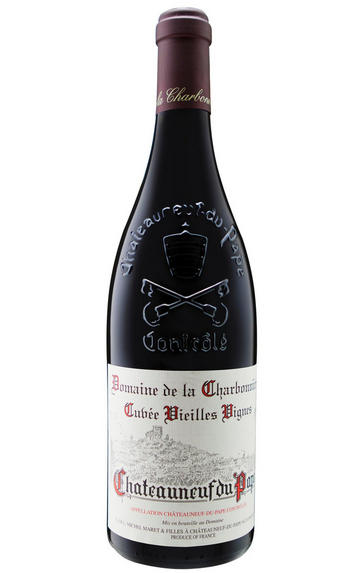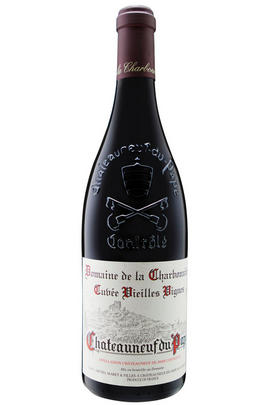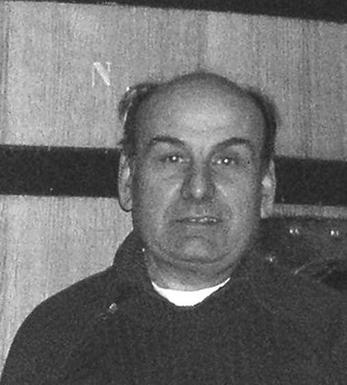
2011 Châteauneuf-du-Pape, Vieilles Vignes, Domaine de la Charbonnière, Rhône

Critics reviews
Jeb Dunnuck - 28/10/2016
One of my favorite estates in the southern Rhone, Domaine de la Charbonniere is run with great passion and enthusiasm by Michel Maret, and more recently, by his two daughters. The Marets own nearly 44 acres in Chateauneuf du Pape, and one of their most under-valued and under-rated wines is their sensational Vacqueyras. They consistently produce four cuvees of Chateauneuf du Pape that are traditionally made, even though a handful of the wines spend time in small oak casks (although new oak is generally shunned at this estate). Other than one large parcel in the northwest sector of the appellation, Maret’s biggest holdings are all in the eastern area of Chateauneuf du Pape. The 2011s are all delicious, fruit-forward, surprisingly well-endowed efforts. As I reported last year, the 2010s are superb, and consumers can’t go wrong with any of these wines, which range from outstanding to prodigious in the case of the Hautes Brusquieres and the Cuvee Vieilles Vignes.
Robert Parker, Wine Advocate #204, Dec 2012
About this WINE

Domaine de la Charbonniere
Domaine de la Charbonnière was purchased by Eugene Maret in 1912. 90 years later and it is still a family-owned affair. The taciturn Michel Maret is a man of the soil, his reticence more than compensated by the eloquence of his wines, on the one hand, and the loquacious nature of his wife on the other. The two charming daughters, Véronique and Caroline, have found respective niches in the vineyard and the commercial function. All in all a complete and happy team, a facet once again echoed in the wines.Domaine de la Charbonniere owns 17.5 hectares of vineyards in the Châteauneuf du Pape appellation, as well as 4 hectares in Vacqueyras. Michel produces wonderfully well balanced wines that combine intensity and depth of fruit with finesse and elegance.
Michel Maret produces a number of different cuvees all from low yields and all bottled without filtration. His village cuvee is one of the best value wines in the appellation while the Cuvée Traditionnelle is a model of balance and purity of fruit.
The Cuvée Vieilles Vignes is produced from La Crau and is silkily rich with marvellous ageing potential while the Hautes Brusquières is a perennial favourite, atypical as it is with its high Syrah component. This is now one of Châteauneuf's leading domains and one can expect the quality to improve even more in the future if past results are any kind of guide.

Châteauneuf-du-Pape
The most celebrated village of the Southern Rhône, Châteauneuf-du-Pape is the birthplace of the now indispensable French Appellation d’Origine Contrôlée system – imperfect though it may be. Compared to the Northern Rhône, the vineyards here are relatively flat and often feature the iconic galet pebbles – the precise benefits of which are a source of much debate. Minimum alcohol levels required by the AOC are the highest in France, but at 12.5% it is well below the natural generosity of Grenache, which only achieves its full aromatic potential when it is fully ripe and laden with the resultant high sugars. Syrah and Mourvèdre contribute the other defining elements in the blend, adding pepper, savoury spice and structure to the decadent Grenache. There are a further 10 permitted red grape varieties which can be used to adjust the “seasoning”. Of the five white varieties permitted, it is Grenache Noir’s sibling – predictably perhaps – Grenache Blanc, which dominates, though Roussanne shows a great deal of promise when handled well, notably at Château de Beaucastel.

Southern Rhône Blend
The vast majority of wines from the Southern Rhône are blends. There are 5 main black varieties, although others are used and the most famous wine of the region, Châteauneuf du Pape, can be made from as many as 13 different varieties. Grenache is the most important grape in the southern Rhône - it contributes alcohol, warmth and gentle juicy fruit and is an ideal base wine in the blend. Plantings of Syrah in the southern Rhône have risen dramatically in the last decade and it is an increasingly important component in blends. It rarely attains the heights that it does in the North but adds colour, backbone, tannins and soft ripe fruit to the blend.
The much-maligned Carignan has been on the retreat recently but is still included in many blends - the best old vines can add colour, body and spicy fruits. Cinsault is also backtracking but, if yields are restricted, can produce moderately well-coloured wines adding pleasant-light fruit to red and rosé blends. Finally, Mourvèdre, a grape from Bandol on the Mediterranean coast, has recently become an increasingly significant component of Southern Rhône blends - it often struggles to ripen fully but can add acidity, ripe spicy berry fruits and hints of tobacco to blends.


Buying options
Add to wishlist
Description
The VieillesVignes is made up of 70% Grenache and 30% Mourvèdre, the venerable vines in question located on the Crau plateau and some not far from centurion status. Savoury and powerful, this is the masculine partner to the more feminine Mourre des Perdrix, with firm tannins, dark spicy fruits and impressive persistence.
Simon Field MW, BBR Buyer
Teamwork is the name of the game chez Maret, with Michel lending expertise to the vinification, Caroline demonstrating aptitude in all matters viticultural, Veronique developing commercial skill and Madame Maret (after whose Christian name I would not presume to enquire) being a very gifted talker. The wines are eloquent too; for Véronique 2011 was not a great year for Syrah. On the other hand Grenache, which dominates the blend, is perceived as a great success, eschewing the dangerously high alcohol levels of the warmer years in favour for something approaching The Golden Mean.
wine at a glance
Delivery and quality guarantee